*Note:
An interview about our spirit collection has been posed on
Marty Weil's ephemera blog.
|
| -Spirit
Photographs in our collection -
Page 1 |
How our collection started - Brewster & Mumler
During 30+ years of collecting we have often found that a sub-collection
will just appear without our being aware that it was happening.
This is the origin (really appropriate when you think about it)
of our collection of spirit photography. We acquired an original
edition of Brewster's book
on the Stereograph and read his instructions for making a spirit
photograph. We then realized that we already had a stereo card
that gave him credit as well as more than
30
other stereos
of "spirits".
We had read about Mumler and were delighted to acquire some of
his carte-de-visites. We then picked up additional carte-de-visites
and cabinet cards here and there and a few books on the subject. When
the eBay internet auction became part of our life we found additional
examples
to
add to our collection.
* Disclaimer * Our
interest is in the photographic and social implications of the
genre
and we have yet to see or read anything that convinces us that
there is no photographic "trick" involved.
|
-Brewster's
Idea
|
|
Early in the practice of the photographic medium ghostlike images
were noticed in images. Because of long exposure times anything
that moved during the exposure was not recorded or was recorded
as transparent. In 1856 Sir David Brewster, an important figure
in the development of the medium, described in The Stereoscope,
Its History, Theory, and Construction how ghosts could be made
to appear in photographs for amusement.
On the right is an English stereo card of the period
called "The Ghost in the Stereoscope" with an acknowledgment
to Brewster.
While Brewster clearly saw this as an amusement and as a photographic
trick others with a growing interest in the paranormal saw "proof" of
the existence of spirits. Photographic seances and demonstrations of "photographing
the invisible" became a familiar fixture in the 19th century. |
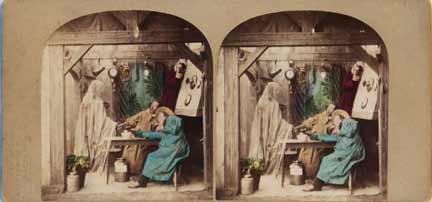

|
Below is the excerpt from chapter XIV "Applications
of the Stereoscope to Purposes of Amusement" of Brewster's The
Stereoscope, Its History, Theory, and Construction says:
"For the purpose of
amusement, the photographer might carry us even into the
regions of the supernatural.
His art,
as
I have elsewhere shewn, enables him to give a spiritual
appearance to one or more of his figures, and to exhibit them
as "thin air"amid
the solid realities of the stereoscopic picture. While
a party is engaged with their whist or their gossip, a
female figure
appears in the midst of them with all the attributes of
the supernatural. Her form is transparent, every object
or person
beyond her being
seen in shadowy but distinct outline. ... In
order to produce such a scene, the parties which are to
compose the group must have their portraits nearly finished
in the
binocular camera, in the attitude which they may be supposed
to take, and
with the expression which they may be supposed to assume,
if the vision were real. When the party have nearly sat
the proper
length
of time, the female figure, suitably attired, walks quickly
into the place assigned her, and after standing a few seconds
in the
proper attitude, retires quickly.. If this operation has
been well performed, all the objects immediately behind
the
female figure,
having
been,
previous to her introduction, impressed upon the negative
surface, will be seen through her, and she will have the
appearance
of an aerial personage, unlike the other figures in the picture."
|
| The London Stereoscopic Company stereo card below from the
series New "Spirit" Photographs dates from the
1860s. |
The buff curved card below, published in 1893
by Littleton View Company is titled The Haunted Lovers.
We have more than 30 stereo cards that show ghosts. |
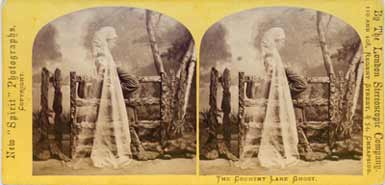 |
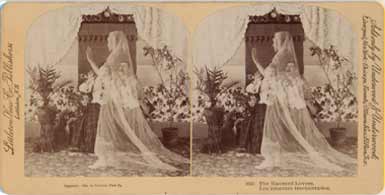 |
|
| -William Mumler's Carte-de-Visites |
|
One of the best known practitioners was photographer William Mumler.
We were fortunate to find carte-de-visites by Mumler and the Harper's
Weekly from May 8, 1869
which
features a story on Mumler's trial for fraud and the cartoon below
that takes a humorous look at a Mumler sitting. A gentleman sits
for
a portrait
and when it is presented he and his fiancee are shocked to find
he is surrounded by his dead wives
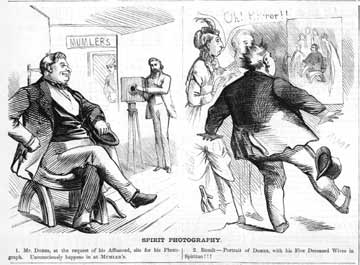
|
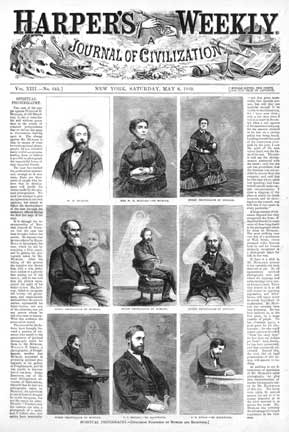 |
Mumler was not convicted because there was insufficient
proof of fraud. He gave demonstrations to skeptics who were unable
to spot any trickery. While they appear to be simple multiple exposures
the controls placed on the experiments suggest that his technique
must have been more complicated. One theory is that he was able to
slip thin sheets of paper with an image into the camera or plate
holder.
Two Mumler cards from our collection are seen below along with
the back of the second card. |
|
|
|
|
We have had the Mumler card above for many years but did
not know the name of the subject. We were sure he was a medium
because,
unlike our other subjects with extras, he was aware of the
presence of the spirit since he is looking at and reaching
for the cross
being passed to him by the ghostly presence.
To our delight there is a reproduction of the same image in
Kaplan's book The Strange Case of William Mumler.
It is from the Getty Museum and identifies the man as Harry
Gordon.
From the internet we learn the Henry C. Gordon (also know
as Harry Gordon) was the first American medium credited with
levitation in February of 1851. |
|
The Mumler card above was purchased at the same time as
the card on the left. The back shows the subject is "Capt Montgomery".
From the Kaplan book we also learned that the subject is Captain
R. Montgomery of Hodgsdon Mills, Maine. The girl holding the flower to his face is said to be
a likeness of his dead daughter. He sat for another Mumler portrait
in which he received a likeness of his mother.
We are researching Captain Montgomery and hope to add more
information about him. Hodgsdon Mills does not appear to be
a current town in Maine but we have found a reference to a
Captain Robert Montgomery who died in 1882 and was buried in
Boothbay, Maine.
|
|
|
